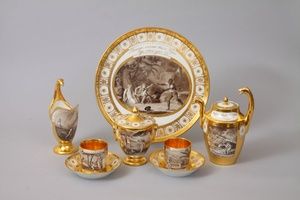История фабрики Даготи Dagoty
История фабрики Даготи Dagoty

Мануфактура Даготи – одно из наиболее выдающихся парижских фарфоровых предприятий первой четверти XIX века. Производство возникает в конце XVIII столетия и стремительно развивается, выпуская продукцию высокого качества, которую ценили не только во Франции, но и в России.
Даготи (Dagoty) – фамилия основателей производства, которая происходит от дворянской формы d’Agoty. Во время Великой французской революции 1789 года наследники соединили «благородную» частичку «de» с фамилией. Историю завода следует начинать с имени Жака Фабьена Даготи (1711 – 1785). Он занимался живописью, физикой, естественной историей, великолепно владел техникой цветной гравюры, которую применял для создания анатомических атласов, и кроме того основал журнал – «Journal de la physique».
Четверо из пяти сыновей Жака Даготи тоже были гравёрами. Старший сын Жан-Батист Андре Готье-Даготи был придворным живописцем королевы Марии Антуанетты. Он писал портреты королевы и именитых придворных, был автором прекрасных гравюр с видами Италии. Трое его сыновей – Пьер-Луи, Жан-Батист-Этьен и Исидор Даготи – стали керамистами и по протекции герцога Ангулемского поступили учениками на мануфактуру Диля и Герара. Здесь они осваивали азы производства. Младший из братьев, Исидор, умер молодым. Пьер-Луи и Этьен в 1798 выкупают небольшую обанкротившуюся мануфактуру в квартале Монпарнас на улице Шеврёз (rue de Chevreuse) и основывают здесь собственное производство. Но вскоре в 1800 году умирает и Этьен. Уладив все юридические формальности, Пьер-Луи Даготи 7 августа 1804 года становится единственным владельцем мануфактуры и в этом же году на бульваре Пуассоньер (Poissonière) открывает один из самых красивых, модных и дорогих магазинов в Париже.
В первое десятилетие XIX века – время расцвета мануфактуры Даготи. Здесь работало больше 100 постоянных сотрудников, в распоряжении которых была одна большая печь, шесть муфелей для обжига декора, кабинет химии и разные мастерские. Предприятие выпускало твердый, хорошо глазурованный фарфор красивого белого цвета. Из него изготавливали скульптуру, барельефы, чайную, столовую и медицинскую посуду, вазы, письменные приборы, корпуса часов.
Изделия отличались высокими художественным уровнем, прекрасным качеством исполнения и были сделаны в духе времени – с использованием богатого лепного скульптурного декора. Это была общая тенденция в производстве фарфора первой четверти XIX века. Ручки ваз и чашек украшались обычно расположенными в верхней части маскаронам, стилизованными цветками и листьями аканта. Навершия крышек оформлялись в виде очаровательных бутонов или пиниевых шишек. Носики чайников и кофейников – в виде клювов птиц или голов животных. В росписи использовались цветочные мотивы, полихромные пейзажи и натюрморты, рисунки сепией с литературными сюжетами и сценами охоты, монохромная роспись «а ля камея». Особую известность принесли мануфактуре античные мотивы.
Уже в начале XIX века считалось хорошим тоном приобрести фарфор Даготи в качестве подарка или сувенира. Ценили изделия мануфактуры и в высших кругах. Так, незадолго до коронации Наполеона Пьер Даготи посылает Жозефине эскизы посуды с её императорским гербом. Работа ей невероятно понравилась, и с 1804 по 1814 год в марке предприятия появляется определение «Мануфактура Императрицы», что подчеркивает личное покровительство супруги Наполеона и делает Даготи, наряду с государственной Севрской фарфоровой мануфактурой, поставщиком высочайшего двора. О заказах Жозефины свидетельствуют записи в книге ее счетов. Когда императрицу сменила королева Мария-Луиза, отношение к поставщику не меняется, и она, как и Жозефина, покровительствует Пьеру Даготи.
Во время финансового кризиса 1806 года практически все владельцы мануфактур обращались за помощью к государству. Даготи не стал исключением. Он просит кредит, аргументируя его тем, что нашёл рынок сбыта в Петербурге и Москве. Вот, что он пишет в 1807 году: «Я занимаюсь исключительно производством вещей хорошего вкуса и по умеренным ценам, я нашёл лёгкую возможность сбыта моей продукции, особенно в Петербурге и Москве… но война прервала наши отношения с Севером».
На промышленной выставке 1806 года Даготи получает серебряную медаль за вкус в разнообразии изделий, матовое и блестящее золото (гладкое и рельефное) и свои цвета. С тех пор цветные фоны приносят успех мануфактуре. Розовый, светло-жёлтый, светло-голубой, алый и часто используемый чёрный фоны прерываются горизонтальными или полихромными медальонами с пейзажами, военными сценами, репродукциями с гравюр басен Лафонтена или просто цветком.
После периода, который вошел в историю Франции как Реставрация (1815-1830), традиция покровительства женщин высшего общества для мануфактуры продолжились. Предприятие переходит под протекцию герцогини Ангулемской. Однако экономические трудности вынудили Пьера Даготи в 1816 году объединиться с предпринимателями отцом и сыном Оноре. По договору они создавали товарищество Даготи-Оноре сроком на 20 лет. Производство здесь было поставлено на промышленный поток. Но проработав четыре года товарищество распадается. Пьер Даготи вынужден покинуть Париж, и его мануфактура прекратила своё существование.
